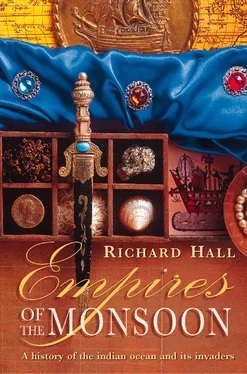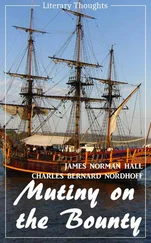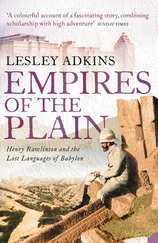A masterpiece of invention, the letter tells of Prester John’s domain, with its crystal waters, great caches of precious stones and forests of pepper trees. 4On a mountain of fire, salamanders spin threads for the precious royal garments. Prester John speaks of his beautiful wives, and of how he limits his congress with them to only four times a year; for the rest of the time he sleeps on a ‘cold bed of sapphire’, to subdue his lust.
In a magic mirror outside his palace, says Prester John, he can discern all the intrigues of his enemies. The letter ends in a grandiose biblical vein: ‘If thou canst count the stars of the sky and the sands of the sea, judge the vastness of our realm and our powers.’ Such imagery played upon Europe’s vague notions of the lurking might of Asia.
One defence of Archbishop Christian, if he were indeed the author, is that fictitious letters were an accepted literary device in the Middle Ages. What made the Prester John forgery so much more potent was the desire in Europe, among kings, priests and peasants alike, to hold it as the truth. At a time when the Crusades had begun to falter and all the prayers asking God to intervene on the side of Christianity seemed in vain, it restored faith in the bond between religion and valour. The mysterious presbyter was an oriental counterpart of those bishops who rode into battle with studded maces in their mailed fists. He was also immensely rich, making popes and archbishops see him as a person after their own hearts, spreading a message which could be set against the urgings of Jesus to be poor and humble.
A few brave spirits, such as the philosopher Roger Bacon, were openly sceptical, hinting that the priest-king might not exist. They went unheeded. Soon the letter was being translated from Latin into almost every European language and dialect; there was even a Hebrew version. Then scribes began weaving their own fancies into it. The next stage was the invention of tales by imaginary travellers of visits to the domain of the divine monarch, and even of interviews with him. Naturally enough, all travellers to the East – especially the friars sent to Cathay by the Church – were told to look out for the Prester. They were questioned on their return: did they see him or, at the very least, did they hear about him? Few dared say no.
Marco Polo had embellished the legend in a rather discouraging way, by declaring that Prester John was long since dead, killed by the Mongol leader Chinghiz Khan in ‘one of the greatest battles ever seen’. The Prester himself had been a Mongol, albeit a Christian, and Marco turned him into a somewhat unpleasant figure whose arrogance led to his own downfall; when Chinghiz had politely asked for his daughter as a bride, Prester John replied fiercely that he would rather ‘commit his daughter to the flames’. That had led to the disastrous war. The descendant of Prester John was a king named George, a mere vassal of the Great Khan.
Even if Marco’s account was highly confused, there was a certain historical basis for it, because back in 1141 an immense battle had indeed been fought in the Katwan valley near Samarkand between the followers of a nomad from north China named Yelu Dashi and the army of Sanjur, a Muslim sultan; the opposing sides were reputed to have thrown a total of 400,000 horsemen into the field, and when Yelu Dashi emerged triumphant he went on to capture Samarkand. Although not a Christian, he was supported by the heretical Nestorians and was sympathetic towards them (even calling one of his sons by the suitably warlike name of Elijah). It is likely that Nestorian merchants had brought news of Yelu Dashi’s victory westwards to the Levant, since it was only three years later that Bishop Hugh of Jabala had travelled to Rome and told there how a great victory had been won ‘in the uttermost East’ by a Christian king named John.
If by the start of the fourteenth century Marco Polo had declared Prester John to be dead – and by any rational judgement, he had to be – the time might seem to have arrived for Europe to stop believing in him. On the contrary, his fame was fanned into new life by ‘Sir John Mandeville’, an imaginary English knight whose fictitious memoirs claimed to be an account of thirty-four years spent travelling in the East.
Who wrote the Mandeville text remains an enigma, but it was someone with a talent close to genius. He was possibly an Englishman born in St Albans, north of London, who in about 1350 had fled across the Channel to Liège – another cathedral city – after committing some grave crime. Perhaps he was a dealer in precious stones, for his narrative reveals a compulsive interest in diamonds. His 70,000-word tour de force was written in French a few years before he died in 1372. At his deathbed was a Liège lawyer and fellow-writer, Jean d’Outremeuse, who has sometimes been wrongly named as Mandeville’s creator.
The surname of the fictitious Sir John could have been derived from William de Mandeville, Earl of Essex, a twelfth-century crusader who sailed from England to the Holy Land with a fleet of thirty-seven ships. (While on this expedition he had helped the Portuguese to fight against the Muslims in a battle during which 40,000 men were killed.) But the stratagems by which the Mandeville author hid his own identity scarcely matter beside the impact of his work on all levels of European society for several centuries. He was not recognized for what he was – a brilliant confidence-trickster who had pillaged the memoirs of many real travellers, Marco Polo among them – but was revered as a trustworthy witness to the world’s wonders.
Mandeville’s Travels was destined to be the first book ever printed in Europe in a language other than Latin, when a Dutch version came out in 1470; by 1500 at least twenty-five editions had appeared. Part of the narrative’s success derived from its grotesque stories, sometimes with a sexual element; even the familiar Roman and medieval tales of lands where husbands invite other men to lie with their wives are worked over once more. This was the kind of earthy secular writing which the Church condemned yet never quite managed to outlaw. The author knew how to forestall religious criticism: as the climax of his story, readers are introduced to the country of Prester John, most virtuous of Christian monarchs.
The writer of the original Prester John letter had motives easy to understand. He wanted to tell the beleaguered Christians of Europe that they were not alone, that succour might be at hand. The motives of whoever called himself Sir John Mandeville are more intriguing, for there was small prospect of financial reward. Perhaps he was merely an ‘armchair traveller’, amusing himself in his last days by drawing together the favourite tales of a lifetime’s reading. Indeed, his closing sentences are distinctly plaintive, talking of ‘rheumatic gouts’ and of ‘taking comfort in wretched rest’. He ends by asking his readers to pray for him; then he will pray for them. If within the work there lies some religious or political motive, it is hard to discern across a gulf of six centuries.
Had he lived to see it, the Mandeville author would have marvelled at the huge and lasting success of his travelogue. One sure result was to sustain the Prester John myth in the minds of those European powers, and in particular, the Portuguese, who were looking for new routes to the Indian Ocean lands of pepper, spices and jewels. To find the priest-king would be a service to God, while acquiring earthly wealth. Thus a medieval legend was destined to buttress the needs of the Age of Discovery: even Columbus, crossing the Atlantic in search of Cipango (Japan) and the land of the Great Khan, had carefully studied Mandeville. It is unlikely, however, that Columbus really expected to meet Prester John, if only because Mandeville had moved the priest-king westwards from where Marco Polo had placed him to become the ‘great emperor of India’. Moreover, the name of the elusive monarch was no longer seen as belonging to an individual; that would strain gullibility too far.
Читать дальше












